|
|
|
Sort Order |
|
|
|
Items / Page
|
|
|
|
|
|
|
| Srl | Item |
| 1 |
ID:
192279
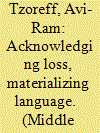

|
|
|
|
|
| Summary/Abstract |
This article focuses on Rabbi Yosef Hayyim's discussions of translation and hermeneutics, as a reflection of the broad movements between languages throughout the Ottoman Empire and the Indian Ocean, and the linguistic inequalities that characterized them. Reading Hayyim against his Baghdadi context, considering the printing and translational activities of the British missionaries of the London Society for Promoting Christianity amongst the Jews and the hermeneutics that were developed in the Baghdadi Salafiyya, I argue that Hayyim's opposition to the translation of Jewish Kabbalistic knowledge should not be seen as a conservative approach that prevents its popularization, but as an understanding of the linguistic power relations involved within the act of translation. Juxtaposed vis-à-vis his uses of Arabic translations in other responsas and his call for the teaching of standard Arabic in Jewish schools in Baghdad, that cohered with the Nahdawi perception of Arabic as a major aspect of the Ottoman Mashriq Arab political community, I argue that these incidents reflect different intersections of languages and power that occurred in the urban sphere of Ottoman Baghdad.
|
|
|
|
|
|
|
|
|
|
|
|
|
|
|
|
| 2 |
ID:
114497
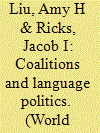

|
|
|
|
|
| Publication |
2012.
|
| Summary/Abstract |
Why is it that some governments recognize only one language while others espouse multilingualism? Related, why are some governments able to shift language policies, and if there is a shift, what explains the direction? In this article, the authors argue that these choices are the product of coalitional constraints facing the government during critical junctures in history. During times of political change in the state-building process, the effective threat of an alternate linguistic group determines the emergent language policy. If the threat is low, the government moves toward monolingual policies. As the threat increases, however, the government is forced to co-opt the alternate linguistic group by shifting the policy toward a greater degree of multilingualism. The authors test this argument by examining the language policies for government services and the education system in three Southeast Asian countries (Singapore, Malaysia, and Thailand).
|
|
|
|
|
|
|
|
|
|
|
|
|
|
|
|
| 3 |
ID:
119969
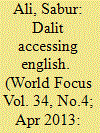

|
|
|
| 4 |
ID:
127028
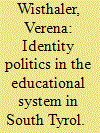

|
|
|
|
|
| Publication |
2013.
|
| Summary/Abstract |
This article focuses on the educational system in South Tyrol as one of the pillars of language and identity politics used for minority protection and elaborates on possible future developments triggered by immigration. After a historical overview of the coexistence of the three linguistic groups in South Tyrol, the article will explore, from the perspective of the educational system, the institutional framework guaranteeing the protection of the German-speaking and Ladin minority and in particular their languages as the most important markers of the particular local identities. The article then examines how the educational system in South Tyrol deals with increasing immigration, assessing the strengths and weaknesses in relation to whether the educational system facilitates, on the one hand, the development of a multilingual society and, on the other, individual language competences and thus individual multilingualism.
|
|
|
|
|
|
|
|
|
|
|
|
|
|
|
|
| 5 |
ID:
118349
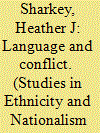

|
|
|
|
|
| Publication |
2012.
|
| Summary/Abstract |
Upon decolonisation, nationalist leaders in two North African countries, Algeria and Sudan, promoted a policy called Arabisation (ta'rib), which sought to impose standard literary Arabic at the expense of English (in Sudan), French (in Algeria), and other local languages (in both places). This language policy reflected the worldview of Muslim leaders, who hoped to break from the colonial past and start afresh while forging alliances with Arab Islamic states. Arabisation succeeded in expanding the use of literary Arabic in Sudanese and Algerian government bureaus as well as in schools and universities. However, in some circles it helped to stimulate oppositional identities that rejected pan-Arabism as a focal point for national pride and that challenged the cultural foundations of national cohesion. Taking a comparative approach, this study argues that Arabic language policy in Algeria and Sudan featured strongly in postcolonial nationalism and civil conflict. It concludes by considering the status of language cultures and policies today in Algeria, the Republic of the Sudan, and the newly independent Republic of South Sudan, and contends that state-led efforts at 'language rationalisation' have not eliminated multilingualism in practice.
|
|
|
|
|
|
|
|
|
|
|
|
|
|
|
|
| 6 |
ID:
142081
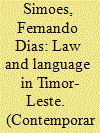

|
|
|
|
|
| Summary/Abstract |
As in other post-conflict states, the international community has been actively promoting the implementation of the rule of law in Timor-Leste. The justice system remains the weakest branch of Timor-Leste’s governance architecture. The effectiveness of the justice system is hampered by the fact that laws and proceedings are not always translated into languages understood by all court actors. Timor-Leste has a long history of multilingualism, with at least sixteen language varieties being spoken in the country. Both Tetum and Portuguese are official languages, with Portuguese being predominantly used in the courts, even though less than 10 per cent of the population is fluent in the idiom. The post-colonial legacy was one of two separate legal systems — the formal legal system and the traditional system — operating in parallel. More than a decade after independence, the former continues to have only a peripheral presence in the lives of most East Timorese. This gap between the language of the people and the language of the courts heightens the challenges to nation- and state-building in Timor-Leste. The purpose of this article is to examine the current language policy in Timor-Leste and discuss possible avenues for strengthening the formal justice system in a multilingual environment.
|
|
|
|
|
|
|
|
|
|
|
|
|
|
|
|
| 7 |
ID:
100293
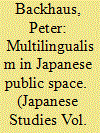

|
|
|
|
|
| Publication |
2010.
|
| Summary/Abstract |
This paper looks at multilingual signs and what these signs have to tell us about multilingualism in Japan in general. Working with a larger sample of signs collected in central Tokyo, it is shown how these signs can be read to reflect larger transformations in Japanese society and its linguistic make-up at large. Four interrelated factors are identified as indicative of these transformations: (1) favourable attitudes toward foreign languages, (2) official internationalisation policies, (3) growing ethnicisation in some areas, and (4) a recent interest in Korean culture and language.
|
|
|
|
|
|
|
|
|
|
|
|
|
|
|
|
| 8 |
ID:
165922
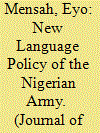

|
|
|
|
|
| Summary/Abstract |
I argue in this paper that the new language policy of the Nigerian Army recognizes and promotes the dominant languages as resources for military training, intelligence gathering and peace building, while the dominated languages are marginalized, alienated and relegated, thus the policy infringes on the fundamental linguistic rights of speakers of minoritized languages in the army. I further maintain that the Nigerian Army’s exclusive language policy is harmful to the army as a national institution and call for explicit status planning of the Nigerian Pidgin to serve as the language of wider communication in the army in response to its emerging sociolinguistic challenges.
|
|
|
|
|
|
|
|
|
|
|
|
|
|
|
|
| 9 |
ID:
101428
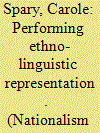

|
|
|
|
|
| Publication |
2010.
|
| Summary/Abstract |
This article explores the performance of ethno-linguistic representation in the national parliament of India, analyzing language practices in debates and ceremonies. Despite a policy of official multilingualism, strong institutional norms prioritize English or Hindi as the two official languages of parliament. However, regional languages are more popular in some forms of debate and ceremonies than others, particularly in the oath/affirmation as a means of affirming cultural identity. I identify three narratives-functional, instrumental, and affective-that Members of Parliament employ to explain language practices in parliament and to show how parliamentary multilingualism is associated with some ethno-linguistic communities more than others.
|
|
|
|
|
|
|
|
|
|
|
|
|
|
|
|
| 10 |
ID:
180691
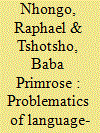

|
|
|
|
|
| Summary/Abstract |
Language policies that are designed in African countries fail to solve communication problems because they are only there to fight the hegemony of English instead of addressing real linguistic problems. The paper analyses the language-in-education policies that were put in place after independence in Zimbabwe. A qualitative approach is used to analyse documents that include the Education Act of 1987, the Nziramasanga Commission, Ministry of Primary and Secondary Education circulars and the Constitution of Zimbabwe. It is argued in this paper that there is a need for the country to come up with policies that are in sync with the linguistic realities that acknowledge the coexistence of languages.
|
|
|
|
|
|
|
|
|
|
|
|
|
|
|
|
| 11 |
ID:
163838
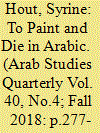

|
|
|
|
|
| Summary/Abstract |
I focus on multilingual usages, specifically code-switching between English and Arabic, in Lebanese American Rabih Alameddine's 1998 novel Koolaids: The Art of War. While the novel portrays English as the emancipatory language of coming out and self-acceptance for gay Lebanese men living in the United States between the late 1970s and mid-1990s, Mohammad, a painter, only comes to terms with his impending demise by reverting to Arabic during the final stages of his losing battle with AIDS. Drawing on findings from psycholinguistic, sociolinguistic, translation, and medical/neurological studies, I compare and contrast verbal encounters between Mohammad and various Lebanese and American characters to foreground strategies intended to exclude and/or include certain parties, be they characters or readers. While Arabic words actually employed are few, I argue that implied code-switching and the dynamics of speaker(s), interlocutor(s), setting(s), and context(s) establish links among AIDS, Arabic, art, and acceptance of death; Arabic resurfaces, when Mohammad is on his deathbed, as the language of his childhood and even serves as the bridge toward his “afterlife.” The primary theoretical impacts of my reading are twofold: minimal code-switching does not, as some claim, showcase shallow multilingualism, and a language-minded approach adds a new dimension to the definition of Lebanese (Arab) American literature by focusing on the emotional rather than the national/ethnic facets of the embedded native language.
|
|
|
|
|
|
|
|
|
|
|
|
|
|
|
|
| 12 |
ID:
172204
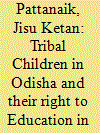

|
|
|
|
|
| Summary/Abstract |
Focused on the socio-economic background of tribal students in the 142 ashram schools of Koraput district in Odisha, this article explores the educational environment and quality of education for tribal children in India. As their educational performance is largely unsatisfactory, the primary causes behind low educational achievements are explored. It is found that the educational processes largely disregard the socio-cultural characteristics and linguistic skills that tribal students bring to the classroom. Specifically, tribal children experience serious language difficulties during the initial years of schooling. The practice of using the dominant state language, Odia, as the sole/dominant medium of instruction in all ashram schools, rather than the children’s mother tongue, appears to leave young learners illiterate in their mother tongue and also fosters low achievement levels in the dominant language.
|
|
|
|
|
|
|
|
|
|
|
|
|
|
|
|
|
|
|
|
|